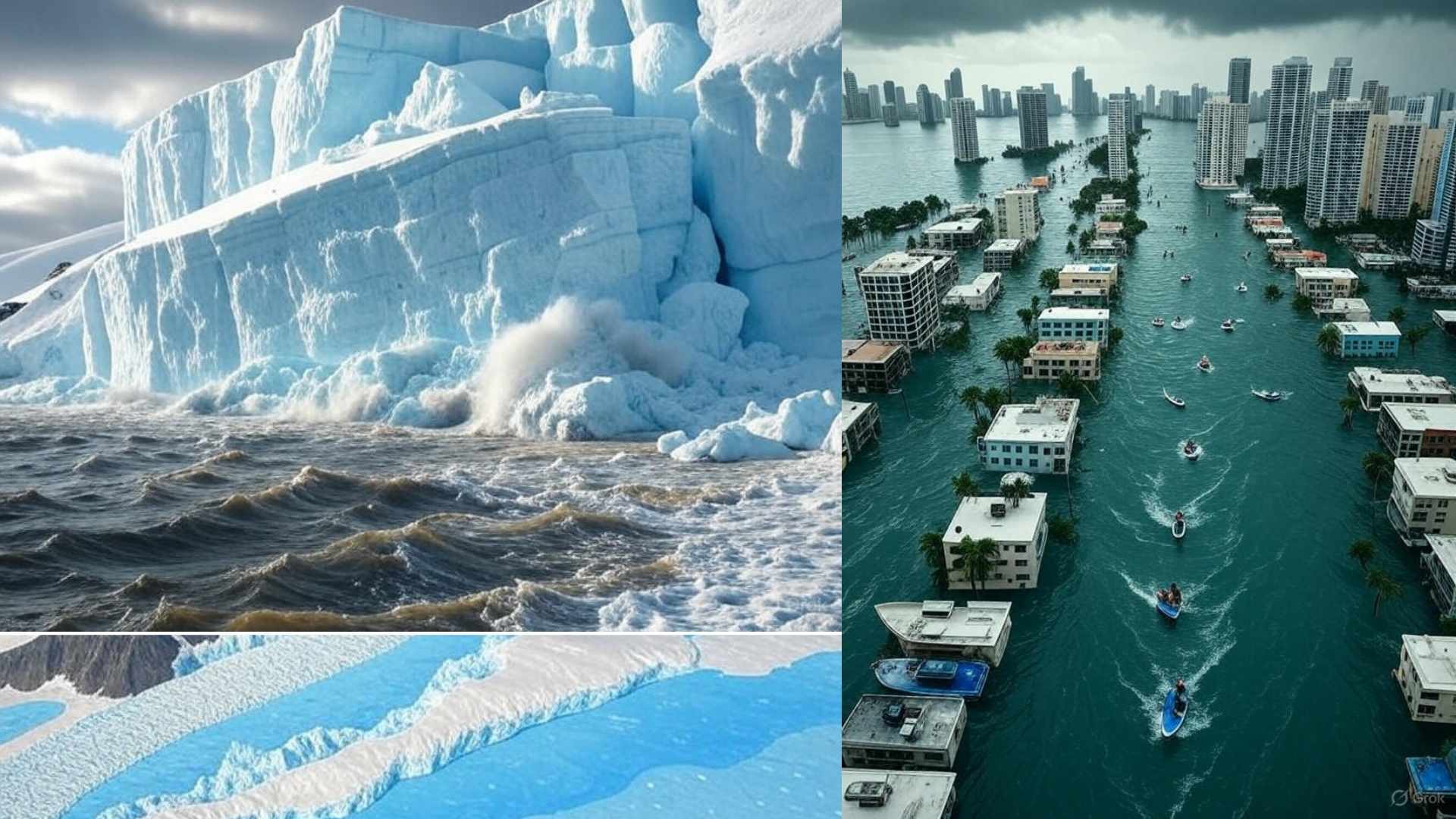Why Doomsday Glacier Melting Faster Than Expected: Are Earth’s Biggest Cities at Risk?
Doomsday Glacier Melting- The Thwaites Glacier, ominously nicknamed the “Doomsday Glacier,” is melting at an alarming rate, raising urgent concerns about global sea level rise. Located in West Antarctica, this massive glacier—roughly the size of Florida or Great Britain—plays a critical role in holding back the West Antarctic Ice Sheet (WAIS). Recent studies reveal that warm ocean waters are accelerating its retreat, potentially threatening coastal cities like New York, Miami, London, and Shanghai with catastrophic flooding. In this blog post, we’ll explore the latest findings on Thwaites Glacier, its impact on global sea levels, and what can be done to mitigate the risks.
What Is the Doomsday Glacier?
The Thwaites Glacier, spanning approximately 192,000 square kilometers, is one of the largest and most unstable glaciers on Earth. It acts as a natural barrier, preventing the collapse of the broader West Antarctic Ice Sheet, which holds enough ice to raise global sea levels by up to 3.3 meters (nearly 11 feet) if fully melted. Thwaites alone contributes about 4% to current global sea level rise, losing an estimated 50 billion tons of ice annually. Its nickname, “Doomsday Glacier,” stems from its potential to trigger devastating sea level rise that could submerge low-lying coastal regions and islands.
Why Is Doomsday Glacier Melting So Fast?
Recent research highlights that Thwaites is retreating faster than previously thought due to warming ocean waters infiltrating its underbelly. A 2024 study from the University of California, Irvine, and the University of Waterloo revealed that tidal currents are pushing warm seawater several miles beneath the glacier, causing “vigorous melting” at its base. This process is exacerbated by:
- Climate Change: Rising global temperatures, driven by human-induced greenhouse gas emissions, are heating the Southern Ocean, accelerating ice melt.
- Polar Amplification: Antarctica is warming more than twice as fast as the global average due to reduced reflectivity (albedo) from melting ice, which absorbs more solar radiation.
- Geographical Vulnerability: The glacier sits on a below-sea-level basin with a backward-sloping seabed, allowing warm water to undercut the ice and destabilize it.
These factors have led to significant ice loss since the 1940s, with retreat accelerating in recent decades. Scientists estimate that Thwaites could collapse entirely within the next 200 years, with some projections suggesting a critical tipping point as early as 2050 if warming continues unchecked.
The Threat to Earth’s Biggest Cities
If Thwaites Glacier collapses, it could raise sea levels by approximately 65 centimeters (25 inches) on its own. However, its failure could destabilize the entire West Antarctic Ice Sheet, potentially leading to a 3.3-meter (11-foot) sea level rise. This would have catastrophic consequences for coastal cities and low-lying regions, including:
- United States: Miami, New York City, New Orleans, and much of southern Florida, including the Everglades, could be submerged. Other at-risk cities include Atlantic City, Charleston, Savannah, and Virginia Beach.
- Global Impact: Cities like London, Shanghai, Mumbai, and Bangladesh’s flood-prone coastal areas face severe flooding risks. Low-lying nations like the Marshall Islands and Tuvalu could become uninhabitable.
- Economic and Social Disruption: Approximately 900 million people—10% of the global population—live within three feet of high tide lines, and a rapid sea level rise could displace millions, causing unprecedented economic and humanitarian crises.
A National Oceanic and Atmospheric Administration (NOAA) projection map illustrates the dire impact, showing southern Florida and parts of California, New York, and Texas underwater in the event of a complete Thwaites collapse.
How Soon Could This Happen?
Predicting the exact timeline for Thwaites’ collapse is challenging due to variables like greenhouse gas emissions and ocean dynamics. However, recent studies provide alarming insights:
- Short-Term Concerns: Some researchers warn that the glacier’s ice shelf, which acts as a butt .ress holding back the ice, could collapse within the next 5–10 years, accelerating retreat.
- Long-Term Projections: The glacier could be lost entirely by the 23rd century, with significant sea level rise occurring as early as 2050 if warming trends continue.
- Tipping Point: Scientists estimate that a global temperature increase of 1.5°C to 2°C could push Thwaites past a critical threshold, triggering irreversible ice loss. The world is currently on track to approach this limit in the coming decades.
While sea level rise will occur more slowly than other climate impacts like heatwaves, the gradual but unstoppable nature of this process underscores the urgency of preparation.
Must Read: A 100 ft Mega Tsunami Could Hit the US at Any Moment
Can We Save the Doomsday Glacier?
Efforts to slow Thwaites’ retreat are being explored, though challenges remain:
- Reducing Carbon Emissions: Limiting global warming by curbing greenhouse gas emissions is the most effective way to slow ice melt. Even if emissions are reduced, residual heat in the atmosphere will continue to drive melting for centuries, but immediate action could delay the worst outcomes.
- Geoengineering Solutions: Some scientists propose ambitious geoengineering ideas, such as:
- Underwater Curtains: Erecting massive barriers to block warm ocean currents from reaching Thwaites’ base, potentially costing up to $80 billion.
- Basal Intervention: Drilling holes to drain meltwater from the glacier’s base, reducing its flow and allowing it to refreeze to the bedrock.
- Bubble Curtains: Injecting air or cold water to create a protective barrier against warm currents.
- Improved Modeling: Ongoing research, like the International Thwaites Glacier Collaboration, uses satellites, underwater robots, and sediment cores to better predict ice loss and refine sea level rise projections.
While geoengineering is controversial and costly, advocates argue it may be necessary to buy time for coastal communities to adapt. Critics, however, emphasize that these solutions distract from the root cause—climate change—and call for stronger global action to reduce emissions.
What Can You Do to Help?
The fate of Thwaites Glacier and global sea levels depends on collective action. Here are ways you can contribute:
- Reduce Your Carbon Footprint: Adopt sustainable practices like using renewable energy, reducing waste, and supporting eco-friendly products.
- Advocate for Change: Support policies and leaders prioritizing climate action and emission reductions.
- Stay Informed: Follow credible sources like the International Thwaites Glacier Collaboration or NOAA for updates on glacier research and climate impacts.
- Support Adaptation Efforts: Contribute to initiatives helping vulnerable coastal communities prepare for sea level rise.
Conclusion: Time to Act Is Now
The rapid melting of the Doomsday Glacier is a stark reminder of the accelerating climate crisis. With major cities like Miami, New York, and Shanghai at risk, the stakes couldn’t be higher. While scientists work to understand and potentially slow Thwaites’ retreat, global efforts to reduce carbon emissions and explore innovative solutions are critical. By acting now, we can mitigate the worst impacts and protect our planet’s future.








3 Comments